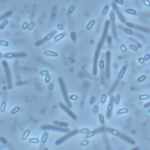Lien vers Pubmed [PMID] – 37965542
Lien DOI – 10.3389/fmicb.2023.1267662
Front Microbiol 2023 ; 14(): 1267662
The dlt operon encodes proteins responsible for the esterification of positively charged D-alanine on the wall teichoic acids and lipoteichoic acids of Gram-positive bacteria. This structural modification of the bacterial anionic surface in several species has been described to alter the physicochemical properties of the cell-wall. In addition, it has been linked to reduced sensibilities to cationic antimicrobial peptides and antibiotics.We studied the D-alanylation of Clostridioides difficile polysaccharides with a complete deletion of the dltDABCoperon in the 630 strain. To look for D-alanylation location, surface polysaccharides were purified and analyzed by NMR. Properties of the dltDABCmutant and the parental strains, were determined for bacterial surface’s hydrophobicity, motility, adhesion, antibiotic resistance.We first confirmed the role of the dltDABCoperon in D-alanylation. Then, we established the exclusive esterification of D-alanine on C. difficile lipoteichoic acid. Our data also suggest that D-alanylation modifies the cell-wall’s properties, affecting the bacterial surface’s hydrophobicity, motility, adhesion to biotic and abiotic surfaces,and biofilm formation. In addition, our mutant exhibitedincreased sensibilities to antibiotics linked to the membrane, especially bacitracin. A specific inhibitor DLT-1 of DltA reduces the D-alanylation rate in C. difficile but the inhibition was not sufficient to decrease the antibiotic resistance against bacitracin and vancomycin.Our results suggest the D-alanylation of C. difficile as an interesting target to tackle C. difficile infections.

